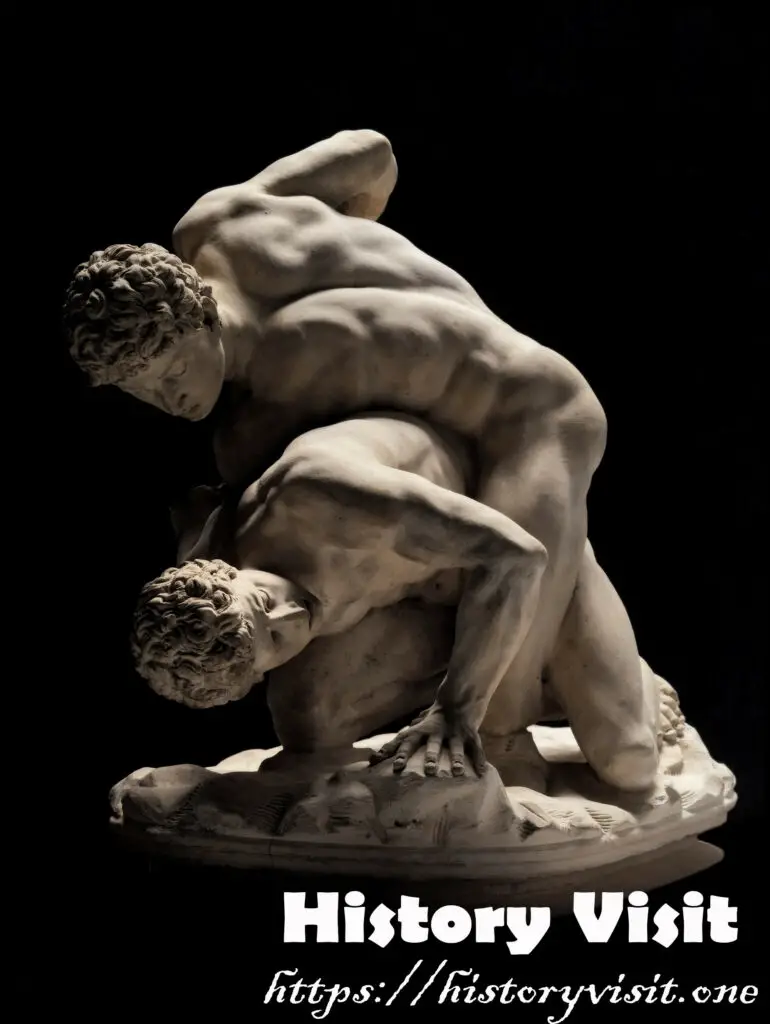Antonio Canova’s “The Wrestlers” (1775): A Triumph of Neoclassical Mastery and Enduring Beauty

Title: Antonio Canova’s “The Wrestlers” (1775): A Triumph of Neoclassical Mastery and Enduring Beauty
Antonio Canova’s magnum opus, “The Wrestlers,” crafted in 1775, stands as an exemplary testament to the artist’s profound mastery and dedication to Neoclassical ideals. Rooted in the historical tapestry of 18th-century Venice, this sculpture not only captures the essence of ancient Greek athleticism but also serves as a powerful embodiment of the Neoclassical resurgence and its lasting impact on the world of art.
In the midst of the 18th century, Europe experienced a cultural reawakening, marked by a renewed interest in the classical past. This Neoclassical movement sought to revive the aesthetic principles of ancient Greece and Rome, celebrating the ideals of balance, harmony, and the sublime. Venice, a melting pot of artistic expression and cultural exchange, became a fertile ground for the manifestation of these ideals. It was in this vibrant environment that Antonio Canova, born in Possagno in 1757, emerged as a sculptor of unparalleled talent.
Commissioned by the Venetian ambassador Girolamo Zulian, “The Wrestlers” was conceived against the backdrop of a society enamored with classical aesthetics. Zulian, a patron of the arts, recognized the power of sculpture to encapsulate the timeless beauty and virtues of antiquity. Canova, guided by the spirit of Neoclassicism, embarked on the creation of a work that would not only pay homage to the ancient world but also elevate the cultural discourse of his time.

Antonio Canova’s skills as a sculptor were nothing short of extraordinary. Trained in the traditions of classical sculpture, he exhibited a deep understanding of anatomy, form, and the nuances of capturing the human spirit in stone. “The Wrestlers” showcases his technical prowess in rendering the intricacies of the human body engaged in the physicality of struggle. Canova’s dedication to perfection is evident in every detail, from the sinewy muscles to the expressions of exertion etched on the faces of the wrestlers. His commitment to the Neoclassical ideals of idealized beauty and harmonious proportions is palpable, setting him apart as a sculptor of unparalleled skill and vision.
The beauty of “The Wrestlers” lies not only in its technical precision but also in its ability to breathe life into stone. Canova’s mastery is such that the sculpture transcends its materiality, exuding a dynamic energy frozen in time. The intertwined bodies of the wrestlers convey a sense of tension and movement, capturing the essence of a fleeting moment. The play of light and shadow on the marble surface further enhances the lifelike quality of the sculpture, inviting viewers to witness the timeless drama of human struggle.
This masterpiece, with its arresting beauty and inherent vitality, had a profound impact on the world of art. “The Wrestlers” became a beacon of Neoclassical excellence, influencing subsequent generations of artists and shaping the trajectory of sculptural expression. Canova’s commitment to classical ideals, coupled with his innovative approach to imbuing life into his creations, set a standard that resonated far beyond the confines of 18th-century Venice.

The impact of “The Wrestlers” on the world of art was twofold. Firstly, it reinforced the Neoclassical movement as a dominant force in shaping artistic expression. Canova’s dedication to classical principles served as a rallying point for artists seeking to break free from the ornate constraints of the Baroque and Rococo eras. The sculpture became a touchstone for those aspiring to capture the enduring beauty and moral virtues espoused by the ancients.
Secondly, “The Wrestlers” contributed to a broader cultural conversation about the human experience. Beyond its classical inspiration, the sculpture resonated with the universal theme of struggle and triumph. In a world grappling with political upheavals and societal transformations, Canova’s work provided a contemplative space where viewers could find solace and reflection in the timeless narrative of human perseverance.
In conclusion, Antonio Canova’s “The Wrestlers” stands as a pinnacle of artistic achievement, a harmonious blend of technical mastery, classical inspiration, and timeless beauty. This sculpture, born from the fertile cultural grounds of 18th-century Venice, transcends its historical context to become a beacon that continues to illuminate the path of artistic expression. Canova’s dedication to Neoclassical ideals and his ability to infuse vitality into stone have left an indelible mark on the world of art, inspiring generations to come and inviting viewers to engage with the enduring narratives etched in the sinewy forms of the wrestling figures.


